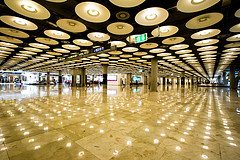1.1 He was entering the museum when...
Quite frequently, the Past Continuous tense is used with one or more verbs in the Past Simple tense. When that happens, the action in the Past Simple took place, that is started and finished, while the action in the Past Continuous was in progress in the past (in Spanish it works in exactly the same way: When Sonia phoned Paco was visiting the city / Cuando Sonia llamó Paco estaba visitando la ciudad).
Listen to the following song, What were you doing last night?, by Jim Reeves, carefully.
|
|
As you can see the singer asks for the action that was in progress (What were you doing?) when something happened: I saw you last night. So, when both tenses are used in the same sentence, the action in the past simple is frequently preceded by when.
On the other hand, we normally use while to introduce the sentence in the past continuous tense. E.g. Paco bought the ticket while he was talking on the phone.
Finally, we can also use two or more past continuous tenses when all the actions in the past were in progress at the same time in the past: While Paco was relaxing in the bar of the hotel, Sonia was phoning him.
Watch the video on the right first to see easy examples.
Remember that the best way to improve your English is to practice it. The more you practice the better for you! So, click here to see a really good presentation that explains the differences and uses of the two tenses we are studying in this section!
And if you want to do more exercises (we recommend you to do so!), we have chosen the following ones in order of difficulty:
Fill in the gaps with the Past Continuous or Past Simple of the verbs in brackets.
 |
| By Éole. C. Commons |
 |
What were you doing when...?
Our lives are full of events, history is full of events, every second an event takes place. Do you know many historical events? Click on the picture to visit an interesting web site where you will be able to read about some of the most well-known events from modern times... Surely, you'll have heard of some of them... but, did you know all?
By the way, what were you doing when these events happened?
 |
| By Olivander. C. Commons |
Time to write!
As you have seen, the Past Continuous tense is quite easy to use. In the passage at the beginning of the topic there are several sentences in the Past Continuous or Progressive tense, and most of them are used together with a Past Simple tense.
Now, it's time to have a look at the different degrees of adjectives to be able to compare people, things, animals or places, which will be studied in topic 5. Before going on to next section, read the passage in section 1 again and try to recognize all the adjectives in the comparative and superlative degree that appear in it. Come on, it's also very easy.